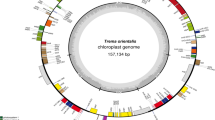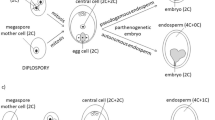Abstract
Chromosomal and karyotype parameters and genome size were examined in 22 Iranian populations of nine different Tulipa species, using squash technique and 1 % (w/v) aceto-orcein stain. Flow cytometric studies were performed using PI staining method and Vicia faba cv. Inovec (2C DNA = 26.9 pg) as a reference standard. Most species were diploid (2n = 2x = 24), having three chromosome types (“m”, “sm”, “st”). The chromosome length (TL) varied from 6.4 μm (S2) to 12.90 μm (S3). Total chromosome volume (TCV) ranged from 32.9 μm3 (S2) to 66.0 μm3 (S8). Statistical analyses confirmed more intraspecific chromosomal and genome size variations than interspecific. S1E2, S2E1 and S5E2, with the highest intrachromosomal (M CA) and relatively high interchromosomal asymmetry (CVCL), indicated higher asymmetry in the karyotype. The genome size in Tulipa species of Iran is being reported for the fist time. The mean 2C DNA was 54.52 pg, and ranged from 77.40 in S6E2 to 31.51 pg in S9E2. Significant positive correlations were found between 2C DNA and either TL or TCV.






Similar content being viewed by others
References
Anjali M, Srivastava AK (2012) Karyological studies in twelve accessions of Carthamus tinctorius. Caryologia 65:1–6
Bennett MD (1998) Plant genome values: how much do we know? Proc Natl Acad Sci USA 95:2011–2016
Bennett MD, Leitch IJ (2012) Plant DNA C-value database. Release 6.0, December 2012. http://www.kew.org/cvalues/. Accessed 17 Dec 2013
Booy G, Van Raamsdonk LWD (1998) Variation in the enzyme esterase within and between Tulipa species; usefulness for the analysis of genetic relationships at different taxonomical levels. Biochem Syst Ecol 26:199–224
Christenhusz MJM, Govaerts R, David JC, Hall T, Borland K, Roberts PS, Tuomisto A, Buerki S, Chase MW, Fay MF (2013) Tiptoe through the tulips—cultural history, molecular phylogenetics and classification of Tulipa (Liliaceae). Bot J Linn Soc 172:280–328
Doležel J, Bartoš J (2005) Plant DNA flow cytometry and estimation of nuclear genome size. Ann Bot (Oxford) 95:99–110
Doležel J, Bartoš J, Voglmayr H, Greilhuber J (2003) Nuclear DNA content and genome size of trout and human. Cytometry 51:127–129
Doležel J, Greilhuber J, Suda J (2007) Estimation of nuclear DNA content in plants using flow cytometry. Nat Protocols 2:2233–2244
Felix WJP, Felix LP, Melo NF, Dutilh JHA, Carvalho R (2011a) Cytogenetics of Amaryllidaceae species: heterochromatin evolution in different ploidy levels. Pl Syst Evol 292:215–221
Felix WJP, Felix LP, Melo NF, Oliveira MBM, Dutilh JHA, Carvalho R (2011b) Karyotype variability in species of the genus Zephyranthes Herb. (Amaryllidaceae-Hippeastreae). Pl Syst Evol 294:263–271
Greilhuber J, Doležel J, Lysák MA, Bennett MD (2005) The origin, evolution and proposed stabilization of the terms ‘genome size’ and ‘C-value’ to describe nuclear DNA contents. Ann Bot (Oxford) 95:255–260
Jafari H, Babaei A, Karimzadeh G, Ahmadi-Roshan M (2014) Cytogenetic study on some Fritillaria species of Iran. Pl Syst Evol. doi:10.1007/s00606-013-0968-6
Jones N (2012) B chromosomes in plants. Plant Biosyst 146:727–737
Karimzadeh G, Mousavi SH, Jafarkhani-Kermani M, Jalali-Javaran M (2010) Karyological and nuclear DNA variation in Iranian endemic muskmelon (Cucumis melo var. inodorus). Cytologia 75:451–461
Karimzadeh G, Danesh-Gilevaei M, Aghaalikhani M (2011) Karyotypic and nuclear DNA variations in Lathyrus sativus (Fabaceae). Caryologia 64:42–54
Leitch IJ, Beaulieu JM, Cheung K, Hanson L, Lysak MA, Fay MF (2007) Punctuated genome size evolution in Liliaceae. J Evol Biol 20:2296–2308
Mahdavi S, Karimzadeh G (2010) Karyological and nuclear DNA content variation in some Iranian endemic Thymus species (Lamiaceae). J Agric Sci Technol 12:447–458
Mozaffarian V (1996) A dictionary of Iranian plant names (Latin, English, Persian). Farhang Moaser Publishers, Tehran, pp 563–565
Naghavi MR, Ranjbar M, Hassani MH, Aghagee MJ, Bamneshin M (2013) Characterization of Iranian accessions of Aegilpos crassa Boiss. using flow cytometry and protein analysis. J Agric Sci Technol 15:811–818
Naranjo CA, Ferrari MR, Palermo AM, Poggio L (1998) Karyotype, DNA content and meiotic behaviour in five South American species of Vicia (Fabaceae). Ann Bot (Oxford) 82:757–764
Newton WCF (1926) Chromosome studies in Tulipa and some related genera. J Linn Soc Bot 47:339–354
Paszko B (2006) A critical review and a new proposal of karyotype asymmetry indices. Pl Syst Evol 258:39–48
Peruzzi L, Eroğlu HE (2013) Karyotype asymmetry: again, how to measure and what to measure? Comp Cytogenet 7:1–9
Peruzzi L, Leitch IJ, Caparelli KF (2009) Chromosome diversity and evolution in Liliaceae. Ann Bot (Oxford) 103:459–475
Ramanna MS, Marasek-Ciolakowska A, Xie S, Khan N, Arens P, Van Tuyl JM (2012) The significance of polyploidy for bulbous ornamentals: a molecular cytogenetic assessment. Floric Ornam Biotech 6:116–121
Rayburn AL, Auger JA (1990) Genome size variation in Zea mays ssp. mays adapted to different altitudes. Theor Appl Genet 79:470–474
SAS Institute Inc (2002) The SAS System for Windows, Release 9.0. Statistical Analysis System Institute, Cary, NC, USA
Seijo JG, Fernández A (2003) Karyotype analysis and chromosome evolution in South American species of Lathyrus (Leguminosae). Amer J Bot 90:980–987
Sheidai M, Zogagi-Far S, Khanafshar S, Zehzad B (2002) Karyotypic study in some Iranian species and populations of Tulipa L. (Liliaceae). Caryologia 55:81–89
Stebbins GL (1971) Chromosome Evolution in Higher Plants. Edward Arnold, London
Urdampilleta JD, Coulleri JP, Ferrucci MS, Forni-Martins ER (2013) Karyotype evolution and phylogenetic analyses in the genus Cardiospermum L. (Paullinieae, Sapindaceae). Pl Biol 15:868–881
Van Tuyl JM, Van Creij MGM (2006) Tulipa Gesneriana and Tulipa Hybrids. In: Anderson NO (ed) Flower breeding and genetics: issues, challenges and opportunities for 21st century, Chapter 23. Springer, Dordrecht, pp 613–637
Zhang YF, Zhang CY, Zhang T, Guan HL, Yan SQ (2010) A cyto-evolutional study of Campanumoea Blume (Campanulaceae) and a possible pathway for secondary karyotype formation. Pl Syst Evol 285:245–257
Zonneveld BJM (2009) The systematic value of nuclear genome size for "all" species of Tulipa L. (Liliaceae). Pl Syst Evol 281:217–245
Zuo L, Yuan Q (2011) The difference between the heterogeneity of the centromeric index and intrachromosomal asymmetry. Pl Syst Evol 297:141–145
Acknowledgments
The authors gratefully acknowledge the support provided for this survey by the Tarbiat Modares University, Iran. We also thank Ms M. Mohseni at the Department of Immunology, Faculty of Medical Sciences, Tarbiat Modares University (TMU) for her technical assistance in flow cytometric analysis.
Author information
Authors and Affiliations
Corresponding author
Additional information
Handling editor: Frank H. Hellwig.
Rights and permissions
About this article
Cite this article
Abedi, R., Babaei, A. & Karimzadeh, G. Karyological and flow cytometric studies of Tulipa (Liliaceae) species from Iran. Plant Syst Evol 301, 1473–1484 (2015). https://doi.org/10.1007/s00606-014-1164-z
Received:
Accepted:
Published:
Issue Date:
DOI: https://doi.org/10.1007/s00606-014-1164-z




